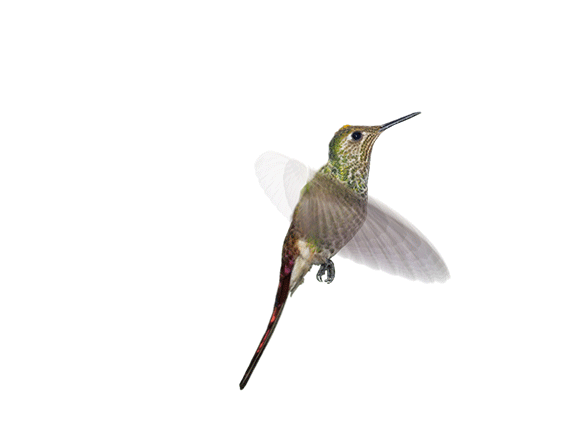Pollinators: Hummingbirds
About the Activity
Explore the role hummingbirds play in the fascinating process of pollination.
See if you can attract a glimmer of hummingbirds! Using recycled materials and simple craft supplies, make your own hummingbird feeder while learning about how these tiny birds pollinate flowers.

Materials
These simple materials will get you started.
recycled glass bottle - remove label (Feeder)
several bright-colored puffy paint (Feeder)
cork stopper-sipper (Feeder)
decorative wire - 12-gauge (Feeder)
disposable table covering (Feeder)
1 cup water (Nectar)
1/4 cup white granulated sugar (Nectar)
Activity Steps
Follow these simple steps to create your hummingbird feeder.
Before you start the activity, think about these amazing facts: With more than 340 different species, hummingbirds are unique to the Americas. As they fly from flower to flower, they sip nectar (they can move their tongues in and out of nectar 13 times per second!) and the pollen gets stuck to their beaks which they drop off at the next flower.
If hummingbirds didn’t help with pollination, there over 8,000 types of flowers in North and South America wouldn’t even exist!
Prepare a disposable table covering under your project. Stand the bottle nose down, begin to paint. (Remember, hummingbirds are attracted to bright colors.) Set aside to dry.
 Did you know?
Did you know?Hummingbirds can travel up to 500 miles at a time. As they travel, they visit hundreds of flowers a day and eat as much as their own body weight in nectar.
Start the wire wrapping twice around the nose. Move wire up to the middle of the bottle and make two wraps. Thread your end through the wraps and then make a loop at the top and go back down the other side to the wraps and tie it off.
Besides insects, hummingbirds have the highest metabolism of all animals. This means hummingbirds need to eat a lot in order to maintain their weight.
Fill the bottle with homemade nectar (see recipe below). Close with the stopper and hang in a semi-shaded area near bright-colored flowers. Now, wait for the hummingbirds to flock.
 Did you know?
Did you know?A flock of hummingbirds is called a bouquet, a glittering, a hover, a shimmer, or a tune.
Hummingbird Nectar Recipe
Ask an adult to help make this recipe.
Ingredients
- 1 cup water
- 1/4 cup white granulated sugar
Directions
Bring 1 cup of water to boil
Add 1/4 cup of white granulated sugar
Stir until dissolved
Boil this mixture for 2 minutes (this will help keep the nectar from spoiling too quickly)
Set aside to cool.
Pour into a clean hummingbird feeder.
Notes:
- For larger recipes, add 4 parts of water to 1 part sugar.
- Nectar can be stored for up to 2 weeks in the fridge.
- Do not use honey as this can cause infection to the hummers.
- Don’t use artificial sweeteners, they have no nutritional value.
- Avoid red dyes as most are unhealthy.
- Clean your feeder once a week.Dispose of unused nectar.
Test Your Knowledge
See how well you know hummingbirds now and find great activities to try next!
Reflection Questions
What would a world without hummingbirds be like?
What makes hummingbirds unique? Why do you think there are so many different species?
What physical traits make hummingbirds good pollinators? Do other birds have these same characteristics?
Investigate and Explore

Take what you’ve learned to the next level to learn more and explore the possibilities.
There are many ways to attract hummingbirds to your feeder. One of the ways is to plant native flowers and plants.
Try to position your feeder away from potential predators such as snakes, raccoons, and even praying mantises. Position the feeder at least 15 feet away from windows to keep hummers from flying into them. Keep them away from the hot afternoon sun to keep the feeder contents from getting spoiled. If you plan on having more than one feeder in your yard, keep them out of sight from each other since hummingbirds are territorial.
On average a hummingbird will flap its wings 50 times a second and can reach speeds as fast as 200 times a second.
The next time you are riding in a car, ask your parents to tell you when they hit 34 mph. That’s how fast a hummingbird can fly.
Want to learn even more about hummingbirds?
Download the 4-H Hummingbird Guide and get to know these fascinating creatures better.




